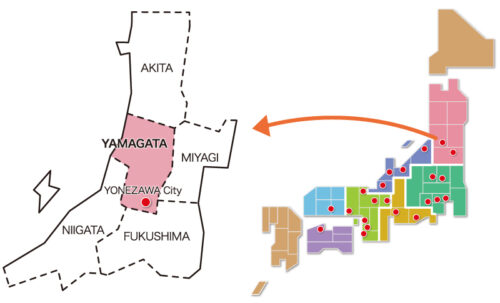Yonezawa Region

Industrial promotion backed up by the Uesugi Family
The Yonezawa region, located at the southern end of Yamagata Prefecture, has a unique textile history. During the Battle of Sekigahara (1600), the defeated feudal lord Kagekatsu Uesugi became an outsider and lost land in the process. He ended up with Yonezawa Domain, and an area of 300,000 koku (as compared to the 1.2 million koku in Aizu Domain originally owned). This spurred him on to breathe new life into the industry within the territory and eventually saw the textile industry proper take root. Towards the end of the Edo Period (1603-1868), the feudal lord Yozan Uezugi rebuilt the Yonezawa Domain with its woven textile - Yonezawa-Ori (Yonezawa weave) - by introducing Ojiya Chijimi (crepes) from Niigata Prefecture. A yarn-dyeing technique using plant-derived dyes such as safflower and indigo was consolidated, whereupon Yonezawa-Ori fabrics and their splendid tonality rose to fame nationwide.
During the Taisho Period (1912-1926), then professor Itsuzo Hata of Yonezawa Technical High School (present-day Yamagata University) devised the first man-made silk yarn (rayon) in Japan, followed by rayon production within Yonezawa City, which catalysed its emergence as a textile hub for natural and synthetic fibres alike. The progress also prompted the development of textiles for western clothing and paved the way for numerous other fabrics, including: yarn-dyed silk textile using dobby looms and jacquard woven with synthetic filaments alongside union cloths with synthetic/silk, all of which acclaimed. The region provides high-grade fabrics for clothing such as ladies’ suiting, coats, alongside one-pieced/formal dresses.
